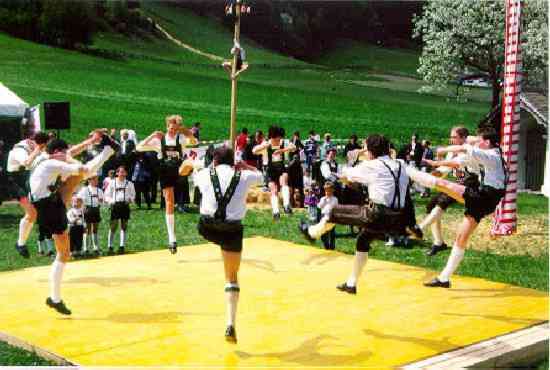
Figure 1.--Schuhplattler are today some of the most popular performers at German ethnic events. White shirts, red ties, and black lederhosen are some of the most common costumes.


Figure 1.--Schuhplattler are today some of the most popular performers at German ethnic events. White shirts, red ties, and black lederhosen are some of the most common costumes. |
Schuhplattler is Bavarian (German) and Tirol (Austria) folk dancing performed in folk costumes (tracht). It includes traditional Schuhplattler and other folk dances. Schuhplatteln literally means "slapping the soles of shoes".. The dance traces its origins to the Alpine areas of Austria and Germany during the 17th century. The origins are believed to hve been very practical rather than contrived. One dance historian reports that the dance developed during the cold winter months. Men would cut wood in the mountains, sometimes staying in isolated cabins. As a form of entertainment they would play music and dance. The dance was apparently influenced by the tendency to jump around aslaps their legs to keep warm. Apparently this developed into competitions to see who could jump the highest or make the loudest slapping noises. Schuhplattler are seen as a typical dance in Alpine area, both German and Austrian, but in fact it was really only native to some regions. Some object to it being view as the typical dance of all of Bavaria and Austria. It is in fact "original" only in some special regions. In traditional Austrinan folk dancing events there are (with VERY rare exceptions) no Schuhplattlers, however, it is very popular today among tourists. As a result it can be widely seen today in Austria as well as Germany. There are only few groups which are dealing seriously with this dance. Lederhosen for Schuhplattler are often made a special cut to heighten the effect of slapping the thighs and bottom. The legs are somewhat longer, almost down to the knees, and tapered to make for a snug fit.
Schuhplattler is Bavarian (German) and Tirol (Austria) folk dancing performed in folk costumes (tracht). It includes traditional Schuhplattler and other folk dances. Schuhplatteln literally means "slapping the soles of shoes".
The dance traces its origins to the Alpine areas of Austria and Germany during the 17th century. The origins are believed to hve been very practical rather than contrived. One dance historian reports that the dance developed during the cold winter months. Men would cut wood in the mountains, sometimes staying in isolated cabins. As a form of entertainment they would play music and dance. The dance was apparently influenced by the tendency to jump around aslaps their legs to keep warm. Apparently this developed into competitions to see who could jump the highest or make the loudest slapping noises. Another historian claims that woodsmen had watched male grouse drumming and strutting in a mating ritual and dance steps were developed to recreate this ritual. The Schuhplattler eventually began dancing at hime in village festivals. Many would of course try to impress the girls. Eventually many different dances evolved and were set to music. By the 19th century girls were also participating.
Schuhplattler are seen as a typical dance in Alpine area, both German and Austrian, but in fact it was really only native to some regions. Some object to it being view as the typical dance of all of Bavaria and Austria. It is in fact "original" only in some special regions. In traditional Austrinan folk dancing events there are (with VERY rare exceptions) no Schuhplattlers, however, it is very popular today among tourists. As a result it can be widely seen today in Austria as well as Germany.
There are only few groups which are dealing seriously with this dance.
There are many different costumes worn by Schuhplattler largely based on the dress of different Alpine regions.
Dance costumes vary. Normally the boys and men wear white shirts and red ties with dark-green velour hats. The hats often have a Gamsbart, the beard of the chamois ("gemse")--Bavarian mountain goats. (Actually it usually is a piece of the goat's main and not his beard. Men and boy dancers normally wear lederhosen. Various styles of lederhosen areworn. One common style is black lederhosen trimmed with green embroidery. Lederhosen for Schuhplattler are often made a special cut to heighten the effect of slapping the thighs and bottom. The legs are somewhat longer, almost down to the knees, and tapered to make for a snug fit. The outfuit normally includes calf socks ("wadenstrümpfe") or full-length socks ("kniestrümpfe". Leather hose ("haferlschuhe") were also worn.
Girls might wear a white blouse with puffed sleeves under a sleeveless dress and laced bodice and a full skirt ("dirndl"). the dresses com in many colors. They are normally worn with aprons, white kneesocks, and black pumps. One tradition is for the girls to wear a edelweiss flower blossom which is worn as a glass encased pendant on a black velvet band.
Navigate the Boys' Historical Clothing Web Site:
[Return to the Main German page]
[Return to the Main lederhosen page]
[Introduction]
[Activities]
[Biographies]
[Chronology]
[Clothing styles]
[Countries]
[Bibliographies]
[Contributions]
[FAQs]
[Glossaries]
[Satellite sites]
[Tools]
[Boys' Clothing Home]
Navigate the Boys' Historical Clothing ethnic pages:
[Main ethnic page]
[German]
[Greek]
[Irish]
[Native American]
[Scottish]
